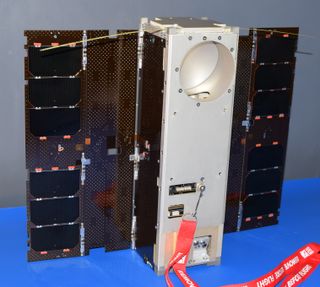Tiny Weather Satellite Will Boost Storm Forecasts
NASA is launching a shoebox-size satellite into Earth's orbit that could help improve weather forecasting.
The Microwave Radiometer Technology Acceleration (MiRaTA) cubesat is expected to launch to space on Tuesday (Nov. 14) alongside another weather satellite called the Joint Polar Satellite System-1 (JPSS-1), and four other cubesats. MiRaTA is designed to study temperature, water vapor and cloud ice, which will be helpful for predicting the weather and tracking storms, according to a statement from NASA. You can watch the launch live at 4:47 a.m. EST (0947 GMT) here on Space.com, courtesy of NASA.
Most weather satellites are very large, but the MiRaTA offers a much smaller and more compact design. The satellite is equipped with two Earth sensors, including a microwave radiometer and a GPS radio occultation (GPSRO) receiver.

A microwave radiometer measures radio-frequency signals related to the thermal radiation emitted by atmospheric gases, such as molecular oxygen and water vapor, and it can also detect particles such as cloud ice. Most weather satellites are equipped with this technology already; however, shrinking the instrument to fit on a CubeSat meant that NASA also had to build a calibration target that was small enough to fit on the miniature satellite.
"You don't have room for the bulky calibration targets that you would normally use on larger satellites," Kerri Cahoy, principal investigator for MiRaTA and an associate professor in the Department of Aeronautics and Astronautics at the Massachusetts Institute of Technology, said in the statement. "Microwave radiometer calibration targets on larger satellites can be the size of a toaster, but for cubesats, it would have to be the size of a deck of cards."
That's where the GPSRO comes in. The technology uses radio signals from other GPS satellites located higher in Earth's orbit to calibrate the cubesat's radiometers. This is important for collecting data that can be used for accurate weather and climate models, officials said in the statement.
"In physics class, you learn that a pencil submerged in water looks like it's broken in half because light bends differently in the water than in the air," Cahoy said in the statement. "Radio waves are like light in that they refract when they go through changing densities of air, and we can use the magnitude of the refraction to calculate the temperature of the surrounding atmosphere with near-perfect accuracy and use this to calibrate a radiometer."
Get the Space.com Newsletter
Breaking space news, the latest updates on rocket launches, skywatching events and more!

If all goes according to plan, the MiRaTA cubesat will be up and running three weeks after launch and will start transmitting validation data within three months of that. The team will analyze data to determine the success of the satellite technology.
"Our goal is to have our radiometers perform just as well as those on current weather satellites and be able to provide the kind of data that helps agencies and people in the path of a natural disaster prepare early and wisely," Cahoy said.
These miniature satellites could also greatly improve weather forecasts, the researchers said. Ideally, MiRaTA would be used to take snapshots of Earth's atmosphere and weather every 15 minutes, allowing scientists to track storms in real time.
"This is a very exciting mission as it will be the first on-orbit demonstration of an all-weather, three-frequency radiometer cubesat using atmospheric GPS-RO-based calibration," Charles Norton, a program associate in NASA's Earth Science Technology Office (ESTO) and the task manager for MiRaTA, said in the statement. "It's a true testament to the creativity and innovation of the teams involved that they're advancing measurement technologies for future small satellite constellation missions."
Follow Samantha Mathewson @Sam_Ashley13. Follow us @Spacedotcom, Facebook and Google+. Original article on Space.com.
Join our Space Forums to keep talking space on the latest missions, night sky and more! And if you have a news tip, correction or comment, let us know at: community@space.com.

Samantha Mathewson joined Space.com as an intern in the summer of 2016. She received a B.A. in Journalism and Environmental Science at the University of New Haven, in Connecticut. Previously, her work has been published in Nature World News. When not writing or reading about science, Samantha enjoys traveling to new places and taking photos! You can follow her on Twitter @Sam_Ashley13.
Most Popular


